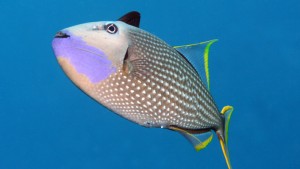As I alluded in an earlier post about the Niger triggerfish (Odonus niger), triggers in general aren’t usually among the first species that come to mind when one is seeking an aquarium specimen with a peaceful disposition. Certainly as far as reef-friendliness is concerned, most of us would probably put triggers as a group somewhere pretty close to the bottom of the list of suitable fishes.
While that viewpoint may be justified in many cases, some triggers are relatively inoffensive toward sessile invertebrates and actually make decent candidates for suitably sized reef systems. Among these is Xanthichthys auromarginatus, the bluechin trigger (a.k.a. the blue-throat trigger or gilded trigger) from the Indo-Pacific.
Physical traits
Typical of triggerfishes, X. auromarginatus is highly laterally compressed (flattened from side to side). This species exhibits sexually dichromatism, meaning there are distinct color differences between the genders. Both sexes are light brown to gray in overall coloration with a myriad of tiny light-blue dots lining their flanks. The males are easy to distinguish from the females by the presence of a distinct blue patch on the chin and the bright yellow margins of their dorsal, anal, and caudal fins.
The maximum recorded length for this species is around a foot, but most specimens are unlikely to achieve that size.
Feeding
In common with others of its genus—e.g., the sargassum trigger and crosshatch trigger (X. ringens and X. mento respectively)—X. auromarginatus feeds primarily on zooplankton drifting in the water column, thus its general disinterest in sessile invertebrates and its reef-worthiness.
Suitable foods include items like mysis shrimp, krill, and various chopped seafoods, such as clams, shrimp, and squid. Food offerings should occasionally be enriched with a vitamin/essential fatty acid supplement.
Planktivores tend to feed continuously throughout the day, snatching any suitable items that float by, so multiple daily feedings are a must for this species.
One personal observation about feeding: X. auromarginatus may be a very shy feeder initially. I once spent nearly two weeks coaxing a specimen to begin feeding in quarantine. My efforts eventually paid off, but it was touch and go for a while there. Once its feeding instincts finally kicked in, however, it became a greedy eater and never looked back.
Housing
I would suggest housing this species in a tank of at least 125 gallons. I’ve come across recommendations for smaller systems, but this species needs plenty of open swimming space in addition to ample rockwork to refuge in, which necessitates a fairly sizeable system in my opinion.
Tankmates
As mentioned, X. auromarginatus is fairly non-aggressive as triggers go and, with the possible exception of very small species introduced after it, usually won’t misbehave toward its tankmates. Any similarly sized, moderately aggressive species should cohabit nicely with this species.
Another possible selling point for X. auromarginatus is that, unlike so many reef fishes, it can be kept in small groups comprised of one male and at least two females provided the tank is sufficiently large (I wouldn’t try it in anything much smaller than the aforementioned 125-gallon).
Of course, it shouldn’t harm or nip at corals or sessile invertebrates, though small ornamental crustaceans might be in danger of becoming a meal.



